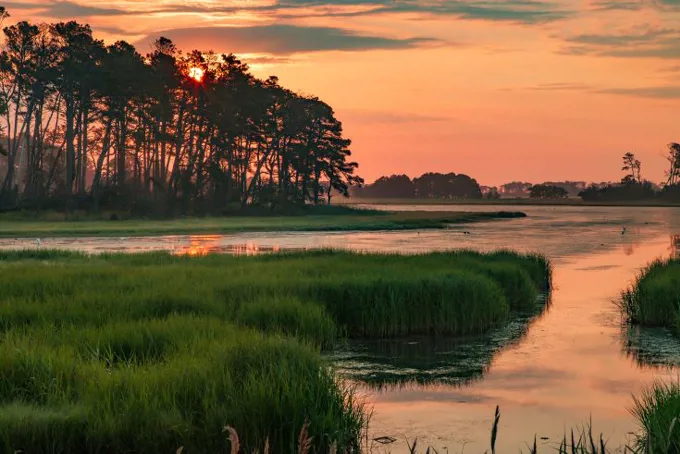
SB776 Requires Proof for Hardened Shoreline Installation
Are the VMRC and Local Wetlands Boards Directed to Stop Granting Hardened Shoreline Permits?
Senate Bill 776 (SB776) directs the Virginia Marine Resources Commission (VMRC) and Local Wetlands Boards to stop granting permits that allow waterfront property owners to install a hardened shoreline “unless the best available science shows that [a living shoreline is] not suitable” (codified at Va. Code §28.2-104.1(D)). The difficulty for the VMRC and Local Wetlands Board is that they will be confronted by waterfront property owners demanding a permit for a hardened shoreline because, in the applicant’s view, the living shoreline is unaffordable. In this article, we consider how the VMRC might appropriately implement the “best available science” standard in SB776.
We have written extensively about this new law because it could require large expenditures by commercial and residential waterfront property owners, and it could force commercial waterfront property owners to modify the manner in which they conduct operations at their facilities. During the month when the new law first took effect we published an introductory article to alert our readership to the new law. Our next article explained what the VMRC is doing to implement the new law. We wrote another article offering guidance on how the new law should be interpreted in the situation where a living shoreline would be vastly more expensive than a hardened shoreline.
A couple examples of living shorelines

(Maria T. Hoffman / Shutterstock.com)

(Jeri Bland / Shutterstock.com)
The property owner who pipes sewage into the river, instead of connecting to the sewage treatment plant, provides an example of how a person’s actions at his property, done with the intention of solving his own pressing immediate problem, hurts others. After centuries of allowing “straight pipes”, laws were enacted forbidding the release of sewage into our rivers. When it comes to hardened shorelines, the VMRC 27 years ago confirmed in its Wetland Guidelines the harm a hardened shoreline causes to others. Although hardened shorelines solve the immediate pressing problem of shoreline erosion at a waterfront property, the VMRC’s Wetland Guidelines state that hardened shorelines hurt others by causing dirtier water in our creeks, rivers, lakes, ponds, bays and territorial sea, worsened flooding of waterfront properties, and diminished commercial stocks of finfish, crabs, and oysters. To lighten this harm, the General Assembly now forbids hardened shorelines “unless the best available science shows that [a living shoreline is] not suitable”.
The VMRC and Local Wetlands Boards will face waterfront property owners who lean on the “best available science” clause as the way to escape the requirement to install a living shoreline. This raises several questions:
- Who has the burden to prove that the “best available science” standard has been met, thus allowing installation of a hardened shoreline?
- What factors should Local Wetlands Boards and the VMRC apply to guide their evaluation of whether the “best available science” standard has been met when considering a particular Joint Permit Application (JPA)?
- How should Local Wetlands Boards and the VMRC evaluate an applicant’s contention that a living shoreline is unaffordable?
I will address the first two of these questions in this article. My next article will consider the question of cost.

(Michael Kalasek / Shutterstock.com)
Burden of Proof Regarding the “Best Available Science” Standard
It would appear that the burden of proof belongs with the waterfront property owner who seeks to use the “best available science” standard to avoid installation of a living shoreline. The VMRC uses the informal factfinding process in the overwhelming majority of situations where the agency is called upon grant or deny a habitat permit for shoreline work. Although there is no law regarding burden of proof that is specifically written for use when the VMRC engages in informal fact finding, the law places the burden of proof on the applicant in most settings comparable to the VMRC informal factfinding process. We see this approach, for example, when an applicant applies for a tax refund from the Commonwealth of Virginia (Cisco Systems v. Thorsen, 68 Va. Cir. 385 (Fairfax County 2005) or applies for a conditional use permit from the City of Virginia Beach (City Council of Virginia Beach v. Harrell, 236 Va. 99 (1988)). In the unusual situation where the VMRC uses the formal factfinding process, Va. Code § 2.2-4020 removes all doubt: “The burden of proof shall be upon the proponent or applicant.” From this it seems safe to conclude that the applicant requesting a permit to install a hardened shoreline will have the burden of proving that his project qualifies under the “best available science” standard.

Factors the VMRC and/or the Local Wetlands Board Should Use When Deciding Whether the Applicant Satisfied the “Best Available Science” Standard
The “best available science” standard is not defined in SB776 nor elsewhere in Virginia law. There are no factors listed in the language of the new statute to guide the VMRC when the agency decides whether the standard is met. The “best available science” standard is however quite well established in federal law and regulation. The federal government has for many decades used the “best available science” standard in its environmental laws and regulations.
Other than a passing mention in Governor Northam’s Executive Order 29 (November 2018), dealing with resilience to sea level rise, drought, hurricanes, flooding, severe storms and wildfires, the “best available science” standard was never used in Virginia law prior to 2020. Breaking with past practice, and presumably influenced by the federal example, the Virginia General Assembly in 2020 placed the “best available science” standard into three newly enacted laws, one of those laws being SB776 (codified at Va. Code §28.2-104.1(D)). The other two new laws adopt the “best available science” standard in connection with the creation of wildlife corridors during planning of highway construction projects (codified at Va. Code §29.1-579) and establishing the social cost of carbon as part of the Virginia Clean Economy Act (codified at Va. Code §56-585.1). In both of these latter situations, the General Assembly listed sources of information that it wanted the agencies to consider when applying the “best available science” standard. The General Assembly offered no such guidance in the language of SB776. During the VMRC’s living shoreline workshops, participants identified numerous sources of information that they believed ought to be included in the “best available science” inquiry for the decision as between living and hardened shorelines. Those information sources include technical expertise available free of charge at the Shoreline Erosion Advisory Service of the Virginia Department of Conservation and Recreation, technical expertise available free of charge at the Center for Coastal Resources Management of the Virginia Institute of Marine Science, site specific analysis regarding sediment transport prepared by an appropriate qualified professional retained by the applicant, technical expertise available free of charge at the Habitat Division of the VMRC, and technical expertise available free of charge provided by the staff at the Local Wetlands Board.
Understanding the "Best Available Science" Standard
There is ample guidance on the meaning of “best available science” in federal law. The standard shows up in the Endangered Species Act, the Safe Drinking Water Act, the Magnuson-Stevens Fishery Conservation and Management Act, the Marine Mammal Protection Act, the Clean Air Act, the Clean Water Act, and other federal laws. Put succinctly, the “best available science” standard is met in federal law when the agency “seek[s] out and consider[s] all existing scientific evidence relevant to the decision". Ecology Center v. U.S. Forest Service, 451 F.3d 1183, 1194 (10th Cir. 2006). The agency may not ignore existing data, and the science upon which it relies “must be good science-that is reliable, peer-reviewed, or otherwise complying with valid scientific methods.” Id.
In some situations there will be numerous sources of data and studies that bear on the question that is before the VMRC for decision. Although the VMRC may not ignore any of those sources, there are federal cases in comparable situations that suggest the agency is entitled to give the weight it deems appropriate to those sources. The thinking behind this principle is that, under the “best available science” standard, “the agency decides which data and studies are the 'best available' because that decision is itself a scientific determination deserving deference." Miccosukee Tribe of Indians of Fla. v. United States, 566 F.3d 1257, 1265 (11th Cir. 2009); San Luis & Delta-Mendota Water Auth. v. Jewell, 747 F.3d 581, 602 (9th Cir. 2014).
It would appear that the VMRC might be guided by these time-proven federal standards unless and until Virginia lawmakers place a gloss of their own on the meaning of “best available science” in the context of SB776.
Conclusion
We have written extensively about this new law because it could require large expenditures by commercial and residential waterfront property owners, and it could force commercial waterfront property owners to modify the manner in which they conduct operations at their facilities. In this article we focus on the legal standards that explain the “best available science” feature of the new law. During the month when the new law first took effect we published an introductory article to alert our readership to the new law. Our next article explained what the VMRC is doing to implement the new law. We wrote another article offering guidance on how the new law should be interpreted in the situation where a living shoreline would be vastly more expensive than a hardened shoreline.
If you have any questions about how wetland laws or living shorelines impact your waterfront property rights, our experienced waterfront law team is happy to help. Feel free to contact us here.
